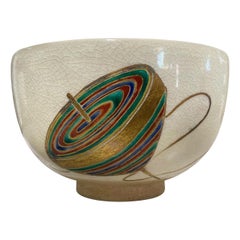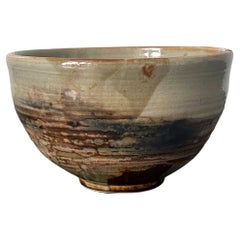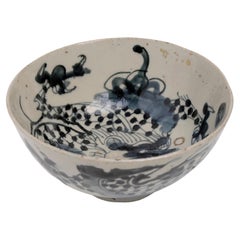Shiko Munakata Decorative Objects
Japanese, 1903-1975
Shiko Munakata is by many regarded as one of the most significant modern Japanese artists of the twentieth century. His art work consists of paintings, prints, ceramics and calligraphy. Looking at his art work, the way he produced it and his fame, one could be tempted to call him the Japanese Picasso of the twentieth century - in every aspect.
Born in Aomori Shiko Munakata was born as the son of a blacksmith in Aomori Prefecture, located in the North of Japan's main island. He first began to paint in oil as a self-taught artist. Later in 1924 he went to Tokyo to study art.
Three years after the artist's death, the city of Aomori opened the Munakata Shiko Memorial Museum of Art. The museum web site has one page with a summary of the career of the artist in English.
At the age of 23 Munakata Shiko saw a woodblock print by Sumio Kawakami and decided to try woodblocks himself. Under the guidance of Unichi Hiratuka he learned the art of making moku-hanga - woodblock prints. Three years later he exhibited four woodblocks at the Shunyokai exhibition.
From then on Munakata Shiko was a hanga artist - a print artist. He continued to exhibit and by and by his reputation grew.
After World War II had ended, the artist became famous outside Japan. His works were shown at the Lugano Print Exhibition in 1952, the Sao Paulo Biennal in 1955, the Venice Biennal in 1956. In each of these exhibitions he was awarded with first prizes. After these successful exhibition, Munakata went to the U.S., where he lectured at different universities and had numerous solo exhibitions.
Munakata Shiko preferred to call his prints banga, which could be translated like picture made from a wooden panel.
Munakata was a practicing Buddhist. Many of his prints and paintings show religious subjects. Other subjects are taken from Japanese legends or from nature.
Munakata's prints are larger than the traditional Japanese oban (10x15 inches = 25.4x38 cm) size. With his larger-sized prints he followed Western contemporary artist's and the buying habits of Western clients. Japanese homes are usually small and have little wall space to hang art work and therefore Japanese art buyers tend to buy smaller sizes.
A Munakata print is usually in black and white. The techniques he used are woodblocks, woodcuts and lithographs. Like Pablo Picasso, Shiko Munakata worked spontaneously, fast and was extremely prolific.
Shiko Munakata died in Tokyo in 1975 at the age of 72.to
1
1
1
1
1
1
1
1
Height
to
Width
to
1
1
1
8
1,369
725
484
475
Creator: Shiko Munakata
Shiko Shikou Munakata Rare Signed Japanese Pottery Chawan Tea Bowl & Signed Box
By Shiko Munakata
Located in Studio City, CA
An exceptionally rare, wonderfully designed Chawan tea bowl by famed Japanese master woodblock printmaker/ artist Shiko Munakata (1903-1975) who is widely considered to be the most important Japanese visual artist of the 20th century and the Pablo Picasso of Japan. This hand-painted work clearly illustrates Munakata's whimsical side as it is of a Koma - a child's spinning top toy. Very few examples of Munakata's work in ceramics exist still today.
The work is signed by Munakata on the base as well as the original wood protective storage box (his seal can also be seen faintly in the lower-left corner).
The bowl has a small kintsugi or "golden joinery" repair - the Japanese art of repairing broken pottery by mending the areas of breakage with lacquer dusted or mixed with powdered gold - on the inside. As a philosophy, it treats breakage and repair as part of the history of an object, rather than something to disguise.
Munakata who is often compared to Picasso was primarily associated with and a principal figure in both the Sosaku-Hanga (which stressed the artist as the sole creator ) and the Mingei (folk art) movements. His many accolades and awards include the "Prize of Excellence" at the Second International Print Exhibition in Lugano, Switzerland in 1952, and first prize at the São Paulo Bienal Exhibition in Brazil in 1955, followed by the Grand Prix Award at the Venice Biennale in 1956, and the Order of Cultural Merit, the highest honor in the arts by the Japanese government in 1970. In 1960 after returning from a year abroad exhibiting his work in the United States, the Horinji Temple in Kyoto bestowed upon him the honorary rank of “Hokkyo”. In 1962, he received the rank of “Hogan” from Nisseki Temple in Toyama prefecture. He also received a Medal of Honor in 1963 and the Asahi Shimbun culture prize in 1965.
Munakata's work can be found in numerous international collections and museums including:
The Britsih Museum, UK
The Chicago Art Institute
Museum of Modern Art (MOMA), NY
The Metropolitan Museum of Art (The Met), NY
The Philadelphia Museum of Art
The Smithsonian American Art Museum (SAAM), Washington DC
Kemper Art Museum, St. Louis
And his own museum The Munakata Shiko...
Category
Mid-20th Century Japanese Showa Shiko Munakata Decorative Objects
Materials
Ceramic
Related Items
Glazed Ceramic Tea Bowl by Toshiko Takaezu
By Toshiko Takaezu
Located in Atlanta, GA
A small elegant glazed ceramic tea bowl (chawan) by Japanese American artist Toshiko Takaezu (American, 1922 - 2011). The well-balanced form is hand b...
Category
Late 20th Century American Modern Shiko Munakata Decorative Objects
Materials
Ceramic
Ancient Japanese Bowl with Dragon
Located in Alessandria, Piemonte
O/1393 - This bowl is more antique tha I wrote. This is one piece from a large collection of ancient pottery, gathered 35 years ago and never exhibited to the public.
I woud like to sell...
Category
Early 20th Century Japanese Other Shiko Munakata Decorative Objects
Materials
Ceramic
Japanese Minimalistic LAAB Fringe Chawan Bowl Raku Ceramics Crackle White
By LAAB Milano
Located in monza, Monza and Brianza
Fringe chawan bowl
Irregular, dramatic gray cracks of bold visual impact embellish the polished ceramic surface of this spectacular chawan bowl, handcrafted following the ancient ...
Category
21st Century and Contemporary Italian Shiko Munakata Decorative Objects
Materials
Ceramic
$201 / item
H 2.76 in Dm 5.91 in
Antique Japanese Shino Ware Chawan Tea Bowl
Located in Atlanta, GA
On offer is a Japanese ceramic tea bowl (chawan) used in the traditional chado ceremony. The bowl was potted in clog form with a ring foot shaved extremely low. Its size and harmonious proportion make it perfect to be held in both hands during chado. Classified as shino ware...
Category
18th Century Japanese Edo Antique Shiko Munakata Decorative Objects
Materials
Ceramic
Islamic Pottery Bowl with Figurative Paint Kashan Ware
Located in Atlanta, GA
An earthenware bowl supported on a foot ring decorated with elaborate slip paint. The bowl was likely made in Kashan (in nowadays Iran) during 12-14th century, in Khwarazmian Empire,...
Category
15th Century and Earlier Persian Islamic Antique Shiko Munakata Decorative Objects
Materials
Ceramic
Antique Japanese Signed Imari Porcelain Plum Shaped Bowl by Hichozan Fukagawa
By Hichozan
Located in Philadelphia, PA
A fine antique signed Japanese Imari porcelain bowl.
In the form of a shaped bowl with a plum-like shape.
Decorated throughout with exquisitely detailed painted or enameled dec...
Category
Late 19th Century Japanese Meiji Antique Shiko Munakata Decorative Objects
Materials
Porcelain
$1,850
H 3.13 in W 8.13 in D 7.88 in
Korean Ceramic Ido Tea Bowl Chawan Joseon Dynasty
Located in Atlanta, GA
A ceramic stoneware chawan tea bowl made in Korea circa 16-17th century. The chawan is identified as Ko-ido (small ido) due to its size and form. Ido bowls were made since 15th centu...
Category
17th Century Korean Other Antique Shiko Munakata Decorative Objects
Materials
Ceramic
Celadon Ceramic Tea Bowl Korean Goryeo Dynasty
Located in Atlanta, GA
An antique Korean ceramic tea bowl with celadon glaze from Goryeo dynasty, circa 12th century. The thin-walled stoneware bowl was potted delicately with...
Category
15th Century and Earlier Korean Archaistic Antique Shiko Munakata Decorative Objects
Materials
Ceramic
Glazed Ceramic Chawan Tea Bowl by Toshiko Takaezu
By Toshiko Takaezu
Located in Atlanta, GA
A small elegant glazed ceramic tea bowl (chawan) by Japanese American artist Toshiko Takaezu (American, 1922 - 2011). The well-balanced form is hand built and shows just a slight irr...
Category
Late 20th Century American Modern Shiko Munakata Decorative Objects
Materials
Ceramic
Small Japanese Oni Hagi Chawan (Tea Bowl) by Seigan Yamane, circa 2010, Japan
Located in Austin, TX
A small but powerful Japanese white oni hagi yaki chawan (teabowl) by renowned contemporary master potter Seigan Yamane (b. 1952), circa 2010, Japan.
The small tea bowl of typical t...
Category
2010s Japanese Shiko Munakata Decorative Objects
Materials
Pottery
$600
H 3.75 in W 4 in D 4 in
Glazed Ceramic Tea Bowl by Toshiko Takaezu
By Toshiko Takaezu
Located in Atlanta, GA
A glazed ceramic tea bowl (chawan) by Japanese American artist Toshiko Takaezu (American, 1922 - 2011). The well-balanced form is hand built and shows...
Category
Late 20th Century American Modern Shiko Munakata Decorative Objects
Materials
Ceramic
Japanese Mino Ware Oribe Type Chawan Tea Bowl
Located in Atlanta, GA
A Japanese Kutsu-gata (clog-shaped) chawan (tea bowl) circa 19th century possibly older. The stoneware bowl potted from buff clay has a slight irregular shape and an unusual depth for a tea bowl. Of Mino ware...
Category
19th Century Japanese Meiji Antique Shiko Munakata Decorative Objects
Materials
Ceramic
Shiko Munakata decorative objects for sale on 1stDibs.
Shiko Munakata decorative objects are available for sale on 1stDibs. These distinctive items are frequently made of ceramic and are designed with extraordinary care. There are many options to choose from in our collection of Shiko Munakata decorative objects, although brown editions of this piece are particularly popular. Prices for Shiko Munakata decorative objects can differ depending upon size, time period and other attributes — on 1stDibs, these items begin at $5,500 and can go as high as $5,500, while a piece like these, on average, fetch $5,500.


